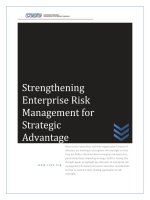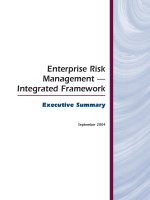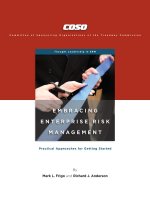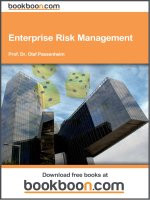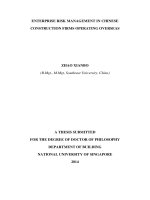Enterprise Risk Management
Bạn đang xem bản rút gọn của tài liệu. Xem và tải ngay bản đầy đủ của tài liệu tại đây (1.95 MB, 36 trang )
EnterpriseRiskManagement
Prof.Dr.OlafPassenheim
Downloadfreebooksat
Prof. Dr. Olaf Passenheim
Enterprise Risk Management
2
Download free eBooks at bookboon.com
Enterprise Risk Management
1st edition
© 2013 Prof. Dr. Olaf Passenheim & bookboon.com
ISBN 978-87-7681-684-1
3
Download free eBooks at bookboon.com
Enterprise Risk Management
Contents
Contents
List of Figures
5
1
Introduction
6
1.1
Risks are Opportunities
6
1.2
Risk Management vs. Enterprise Risk Management
7
1.3
Framework of ERM
9
2
Enterprise Risk Management
14
2.1
Events – Risks and Opportunities
14
2.2
Deinition of Enterprise Risk Management
15
2.3
he ERM framework
16
2.4
he ERM process
18
2.5
Risk Culture
34
3
Conclusion and Outlook
35
www.sylvania.com
We do not reinvent
the wheel we reinvent
light.
Fascinating lighting offers an ininite spectrum of
possibilities: Innovative technologies and new
markets provide both opportunities and challenges.
An environment in which your expertise is in high
demand. Enjoy the supportive working atmosphere
within our global group and beneit from international
career paths. Implement sustainable ideas in close
cooperation with other specialists and contribute to
inluencing our future. Come and join us in reinventing
light every day.
Light is OSRAM
4
Download free eBooks at bookboon.com
Click on the ad to read more
Enterprise Risk Management
List of Figures
List of Figures
Figure 1:
Missing alignment of ERM and operational Risk Management
Figure 2:
Integrated enterprise risk management
Figure 3:
Risk Management Process
Figure 4:
Risk Identiication
Figure 5:
Elements of a business plan
Figure 6:
Evaluation of Risks
Figure 7:
Risk Matrix
5
Download free eBooks at bookboon.com
Enterprise Risk Management
Introduction
1 Introduction
1.1
Risks are Opportunities
Earlier, so it seems, the world was less dangerous. Today, more and more enterprises with innovative,
complicated technologies and sensitive know-how work at an international level. he greater, the stage
becomes on which they move and the more complicated the role they play, the more numerous become
the traps which potentially endanger the achievement of the enterprise’s aims. Hence, raised attention
and suitable instruments to play this game are – especially in a diicult economic sphere – more than
ever compulsory.
Today new technologies are under the magnifying glass to a much greater extent that previously. here
might be two reasons for this. Firstly, nowadays, most economic disasters are published worldwide within
seconds and become known in an instant. Secondly, many new technologies are considered to be risky:
James Watt in his time produced steam boilers with one rather low overpressure risk. A malfunction
with one of his machines would have had an efect of only some meters and would have been limited
to a short time span. However, “modern” catastrophes like Chernobyl had an efect of some thousand
kilometers and the resultant radioactivity may still be problematic for many generations to come.
he combination of fast communication and a wider spread of the efects of errors are responsible for the
call for risk management at an enterprise level. Company scandals like those at Enron, Swissair and AIM
have devastated the stock market and diminished the overall value of stocks by several billion dollars.
Trust in the controlling ability of the auditors with regard to stock market supervision has been lost.
Pension funds, the big inanciers of the 21st century, require transparency in the form of a professional
evaluation of the business risks and an open communication of the most important dangers which a
business might face.
Complex markets, an advancing regulation density and rising requirements for the transparency and
efectiveness of companies are only few of various business risks. Questions by the shareholders or
the board of directors regarding the actual risk situation of the company oten result in the need for
comprehensive auditing of the actual risk situation.
6
Download free eBooks at bookboon.com
Enterprise Risk Management
1.2
Introduction
Risk Management vs. Enterprise Risk Management
As a consequence of economic crisis many executives now recognize that single risks can be valued
realistically only in their interaction with other risks. Risks should no longer be regarded isolated, but
be identiied, analyzed and controlled within the framework of all interacting risks. As recent studies
conirmed, almost every company looks at these risks in isolation. During the past years, separate
subsystems have developed in many companies, for example, on account of legal requirements for the
management of risk. hese companies look at single risk ranges, for example Treasury or Compliance.
he dependence between the risks oten remains unnoticed.
he management of risk up to now places the main focus on avoiding the repetition of errors made in the
past. he fact that basic conditions can quickly change, like competitive environments or raw materials
prices, are oten out of sight. Structures for the risk management in a company as well as models and
methods for risk management which are based on established, statistical and technical experiences do
not always consider the constant changes in the market environment and in the company structure. What
is oten missing is a logical alignment of risk management with strategic business goals (see igure 1).
ERM
Risk Strategy
Risk Report
(Key-Risk-Indicators)
Structural Organisation
Process Organisation
Operational Risk Management
•
•
•
•
Strategy
Risk Identification
Risk Analysis
Risk Response
Risk Controlling
Organisation
Internal Control System
Internal Audit
Alignment
Processes
Emergency Concept
Strategic ERM Appoach
Risk Management
Competence („Toolset“)
Figure 1: Missing alignment of ERM and operational Risk Management
7
Download free eBooks at bookboon.com
Enterprise Risk Management
Introduction
he challenge for a company is to bring together its established subsystems with the goal to develop
an integrated, company-wide risk management system with dynamic structures. To make the risk
management function, it must orientate itself not only to the goals of the company, but also to its strategy
and culture. he goal a company wants to achieve with its risk management strategy must be compatible
with the overall business objectives. Parallel, lessons learnt from risk management can also lead to an
adaptation of the business’ objectives and corporate strategy (see igure 2).
Figure 2: Integrated enterprise risk management
he industry in which a company acts and the business model are other factors of inluence for a companywide risk management model. For a company in the chemical industry, for example, environment
protection orders have a high value. In the insurance industry the minimum requirements inluence risk
management (MaRisk VA) as the risk management must be followed and are monitored.
Finally, companies must look at the complete risk sphere in which they move. Beside the classical risks
which can be strategic, inancial and operational nature or concern the legal environment, so-called
emerging risks must be also considered. Emerging risks are global risks which can be predicted only
hard, for example climate change, political instability or volatile energy prices.
8
Download free eBooks at bookboon.com
Enterprise Risk Management
1.3
Introduction
Framework of ERM
here is not yet an internationally binding framework for enterprise risk management. Even terms like
“Corporate Governance”, which seems to be understood in the same way by most companies, have no
binding legal background in most cases but are more a declaration of will towards the share- and the
stakeholder. Nevertheless, there are some frameworks which can be used as a platform to get enterprise
risk management started:
• ISO 31000
• Sarbanes Oxley Act
• Corporate Governance Codex
• COSO and COSO II
1.3.1
ISO 31000
Since end of 2008 there is a valid worldwide standard on the subject risk management: he international
norm is ISO DIN 31000. Together with the revised ISO guide IEC 73 “Vocabulary”, this norm was
published at the end of 2009.
In the new ISO 31000 three principles are anchored: Firstly, risk management is understood to be an
executive function. Secondly it is tried in the norm to move a so-called top-down estimate and thirdly,
the ISO 31000 shows a very generally held base which tries to consider all the diferent risks within an
organisation.
he ISO 31000 came, like the quality management norm ISO 9001, via general recommendations to
allow a wide applicability. Paralleling this, three guides were published for the successful application of
the ISO 31000:
• Embedding of risk management in the management system
• Methods of risk assessment
• Emergency management, crisis management and continuity management
Risk management sees the ISO 31000 as an executive function. he complete risk management system is
based on the principle of the PDCA cycle (Plan-Do-Check-Act): he irst step, “plan”, contains the risk
politics of the organisation, order and liability. he second step, “Do”, contains the real risk management
process consisting of the execution of risk identiication – risk analysis – risk valuation – risk handling.
Aterwards the ISO 31000 recommends in the third step, “Check”, to check the adapted risk coping
strategies and with ascertained deviations from the plan in the fourth step, “Act”, to remove them.
9
Download free eBooks at bookboon.com
Enterprise Risk Management
Introduction
While up till now only very speciic risk management norms have existed, for example, the ISO 27005
in the area of Information Security Management (ISMS), the ISO 31000 tries with a comprehensive
top-down approach to register all risks and their handling within an organisation. his means a risk
management ater ISO 31000 is not only to be settled exclusively on a strategic enterprise level, but it
also deals with the risks to operational management levels within the company.
1.3.2
Sarbanes Oxley Act
he Sarbanes Oxley Act is a regulation which passed the US Congress in 2002 as a reaction to diferent
inancial scandals. It serves primarily to recover the trust of investors in the general capital market and
applies rules and standards by which company functions in order to raise the level of transparency
between their inancial reporting and the markets.
he Sarbanes Oxley Act is directed equally at the executive boards of companies and chartered
accountants. Ater major inancial scandals, criticism arose as well regarding the information policy
as lacking responsibility for the behavior of managers. As a counteraction, regulations and reinforced
controls should be realized. he inancial scandals of the US companies, Enron and Worldcom, initiated
this course of action.
360°
thinking
.
Discover the truth at www.deloitte.ca/careers
10
Download free eBooks at bookboon.com
© Deloitte & Touche LLP and affiliated entities.
Click on the ad to read more
Enterprise Risk Management
Introduction
he energy group, Enron, ranked within the top 7 US companies up until its breakdown in 2001. In
1996 its stock exchange value 50 billion US $. Its main business was commodities trading as well as the
distribution of futures contracts on gas. For years the group reported proits until in the third quarter in
2001 a loss of more than 600 million US $ was suddenly announced. Moreover, a retrospective correction
of the trading results for the last four years of about 580 US $ was reported. Aterwards it turned out
that the information policy and dubious balance sheet transactions on the public record had clouded
the exact inancial situation of the company.
Charges were also raised against the chartered accountants who did not understand or reveal the situation
in time so that investors were completely surprised by the sudden corrections.
he Sarbanes Oxley Act should lessen the level of inluence of investors and ascribe new duties and
regulations for a company, their corporate governance and their chartered accountants to enable
preventive actions to take place.
Sarbanes-Oxley contains 11 titles that describe speciic mandates and requirements for inancial reporting.
Each title consists of several sections, which are:
1. Public Company Accounting Oversight Board (PCAOB)
2. Auditor Independence
3. Corporate Responsibility
4. Enhanced Financial Disclosures
5. Analyst Conlicts of Interest
6. Commission Resources and Authority
7. Studies and Reports
8. Corporate and Criminal Fraud Accountability
9. White Collar Crime Penalty Enhancement
10. Corporate Tax Returns
11. Corporate Fraud Accountability
Critics of the Sarbanes Oxley Act argue that the act is merely a combination of already existing regulations
which bring about obstacles for small and medium enterprises in achieving their IPO.
1.3.3
Corporate Governance Codex
Corporate Governance can be understood basically as the company’s rules of management and control.
Corporate Governance provides a juridical and general framework, in particular with regard to the
integration of the company in its environment and difers in that aspect from the company constitution
which deals primarily with the internal regulation of a company.
11
Download free eBooks at bookboon.com
Enterprise Risk Management
Introduction
Up till now still, no uniform understanding or uniform deinition of what Corporate Governance means
exists. However, in general Corporate Governance can be understood as the totality of all international
and national rules, instructions, values and principles which are valid for a company to determine
how these are managed and monitored. In the literature one can regularly read discussions about good
Corporate Governance or the improvement of existing Corporate Governance.
• Functioning business management
• Safeguarding the interests of diferent groups (e.g., of the Stakeholder)
• Target-oriented cooperation of the company’s management and control
• Transparency in company communication
• Adequate handling of risks
• Management decisions are targeted to be long-term and value added.
he guidelines of the OECD regarding Corporate Governance are less comprehensive as a
recommendation – no obligation – towards a common and least standards of a TQM or the EFQM
model because only the rights of stakeholders as established by law are considered.
1.3.4
COSO and COSO II
he original COSO model goes back to the year 1992 and is more focused upon the work of chartered
accountants. COSO stands for the Committee of Sponsoring Organizations and its members are recruited
from the Institute of Internal Auditors (IIA), American Institute of Certiied Public Accountants (AICPA),
Financial Executives International (FEI), the American Accounting Association and the Institute of
Management Accountants (IMA).
COSO supports, within the scope of the internal monitoring system, optimization of internal checks
and alignment towards the company’s goals. he basic idea of COSO is the combination of tasks and
components of an internal control system. Components of the internal control system are operations,
inancial reporting and compliance.
COSO II in 2004 was expanded to include the area of Enterprise Risk Management. he basic assumption
of ERM is that every organisation creates values for speciic interest groups. At the same time, all
organizations and management should consider it their task to determine the level of insecurity they
are prepared to accept.
12
Download free eBooks at bookboon.com
Enterprise Risk Management
Introduction
COSO II describes eight interrelated but diferent components of enterprise risk management which
are: (for further detailing go to www.coso.org):
• Internal Environment – he internal environment encompasses the tone of an organization,
and sets the basis for how risk is viewed and addressed by an entity’s people, including risk
management philosophy and risk appetite, integrity and ethical values, and the environment
in which they operate.
• Objective Setting – Objectives must exist before management can identify potential events
afecting their achievement. Enterprise risk management ensures that management has in
place a process to set objectives and that the chosen objectives support and align with the
entity’s mission and are consistent with its risk appetite.
• Event Identiication – Internal and external events afecting achievement of an entity’s
objectives must be identiied, distinguishing between risks and opportunities. Opportunities
are channelled back to management’s strategy or objective-setting processes.
• Risk Assessment – Risks are analyzed, considering likelihood and impact, as a basis for
determining how they should be managed. Risks are assessed on an inherent and a residual
basis.
• Risk Response – Management selects risk responses – avoiding, accepting, reducing, or
sharing risk – developing a set of actions to align risks with the entity’s risk tolerances and
risk appetite.
• Control Activities – Policies and procedures are established and implemented to help ensure
the risk responses are efectively carried out.
• Information and Communication – Relevant information is identiied, captured,
and communicated in a form and timeframe that enable people to carry out their
responsibilities. Efective communication also occurs in a broader sense, lowing down,
across, and up the entity.
• Monitoring – he entirety of enterprise risk management is monitored and modiications
made as necessary. Monitoring is accomplished through ongoing management activities,
separate evaluations, or both.
Enterprise risk management is not strictly a serial process, where one component afects only the next.
It is a multidirectional, iterative process in which almost any component can and does inluence another.
he COSO II approach to the ERM shows a supplement of the classical estimate COSO of the internal
control system. he main focus is on the area of general, company-wide risk management and therefore
puts a spotlight on the strategic approach. Not only are risks considered, but also opportunities. his
approach can be used to extend the internal control system of a company and to develop a more
comprehensive risk management system.
13
Download free eBooks at bookboon.com
